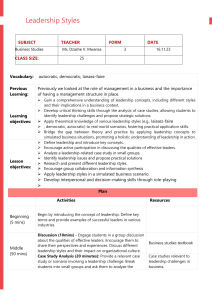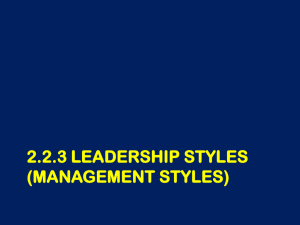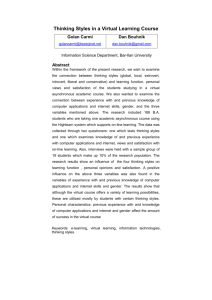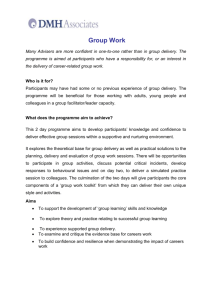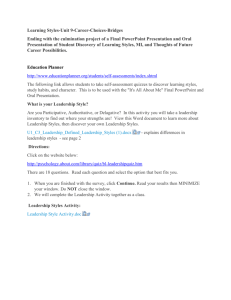Leadership and leadership Styles
advertisement
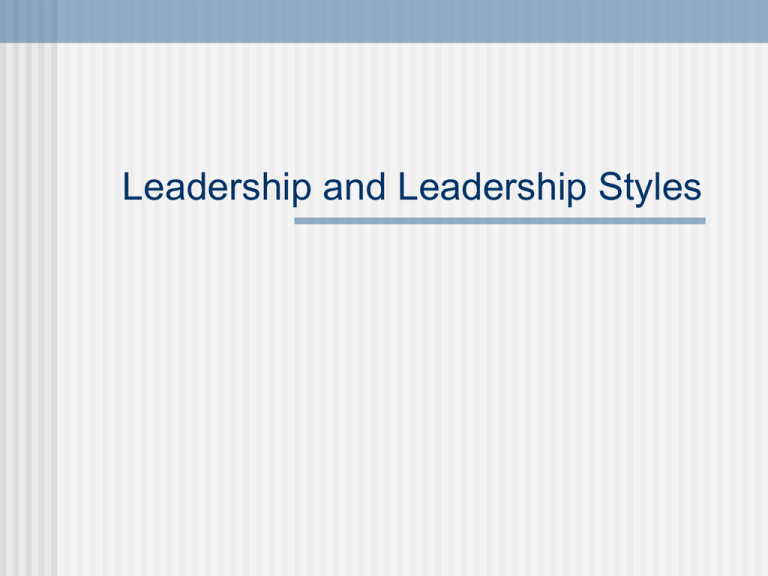
Leadership and Leadership Styles Leadership - what is it? “influencing people so that they will strive willingly towards the achievement of group goals” 1 1 Koontz, H. and C. O’Donnell. “Management: A System of Contingency Analysis of Managerial Functions”. McGraw-Hill, New York, 1976. Analysis of leadership effectiveness 1. 2. 3. Define and measure some criteria of organizational effectiveness Assess leadership style of organization’s leaders Attempt to correlate organizational performance with leadership styles How important is a leader? In most cases, people will perform at about 60% of their potential with no leadership at all Thus, an additional 40% can be realized if effective leadership is available capability utilization Contribution due to leadership ability of manager 40% Default contribution due to need for a job, peer pressure, etc. 60% The 2 dimensions of management Economic or productivity-based 1. “concern for production” Employee condition and morale 2. “concern for people” The 2 dimensions of management These can also be thought of as: 1. Initiating structure (get it done) 2. Consideration (human condition) Styles of leadership X X X Consideration X X Initiating structure Styles of leadership 9 Benevolent Leader (Y) Team Leader (Z) concern for people Laissez-faire Leader (L) 1 Autocratic Leader (X) concern for production 9 Which style of leadership works best? Team Leader (Z) has proven to be the most effective in general (9,9) Requires a “balancing act” of getting things done and having a genuine concern for people Certain special situations may require other styles (i.e. making the atom bomb) Theory “L”: Laissez-faire leader Uninvolved - “leave them alone” Sees main role as passer of information Lets others make decisions Basically abdicates responsibility for team or unit Theory “X”: Autocratic leader Lacks flexibility Controlling and demanding “carrot and stick” approach Focused solely on productivity Theory “Y”: Benevolent leader Very people oriented; encouraging Organizes around people Can be paternalistic “country club” atmosphere: noncompetitive Theory “Z”: Team leader Balances production and people issues Builds a working team of employees Team approach: involves subordinates Organization is a vehicle for carrying out plans Results of leadership styles Theory L: “missing management” 1. Very low productivity Theory X: “my way or the highway” 2. Job stress; low satisfaction; unions form Theory Y: “country club” 3. Low achievement; good people leave Theory Z: “good manager” 4. High productivity, cooperation, low turnover, employee commitment Origins of leadership Are leaders born or made? BOTH. Evidence that both inherent personality and environment are factors What kind of leader would you be? Summary Learn to identify style of your manager If possible, seek a Theory Z environment More common in recent years Get management training Inherent leadership styles can be changed, but takes effort
